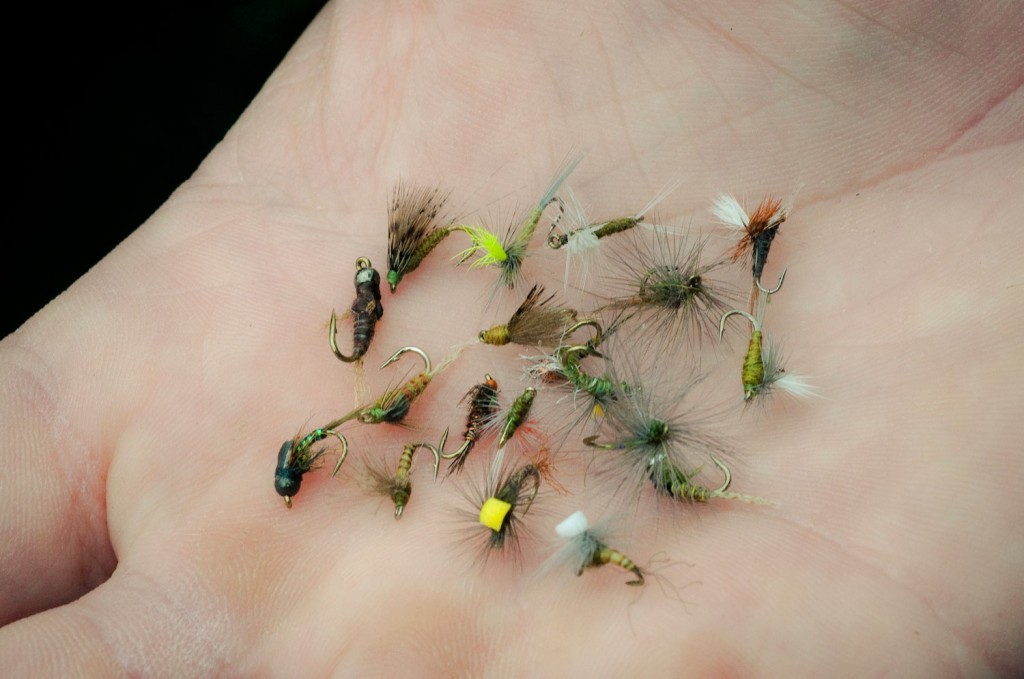
Example of me covering a hatch with multiple fly patterns on hand (BWO Hatch). Photo By: Louis Cahill
Have you ever been standing in the river watching a big hatch unfold with rising fish all around you but no matter how hard you try you can’t get the feeding fish to eat? Covering and hatch from top to bottom starts with you first having the correct fly patterns on hand. When you know you’re going to encounter a specific hatch on the water, always carry multiple variations (colors, sizes) and stages (nymph, emerger, dun, spinner) to make sure your bases are covered. Trout can get really picky during selective feeding and if you don’t have a deep enough bench of fly patterns you very well could miss out on all the action.
This very situation happened to me last year running a guided float trip during an intense sulphur hatch. There was yellow everywhere, and fish were in a feeding frenzy, but the trout wouldn’t eat any of my sulphur patterns I tied on for my clients. Even my CDC go-to patterns that always work were shunned by the feeding trout. I finally found a sulphur pattern after my seventh try that the trout will willing to eat and it saved the day for me. It ended up being nothing special, just a dun with in a slightly different color shade on its abdomen. The remainder of the float trip all I could think about was how important it was that I had so many different sulphur imitations on hand. It would have been a long quiet drive back if my clients witnessed an epic hatch with perfect conditions, and we ended up striking out on the water.
Your standard parahcute style dun with a small nymph dropper off the back will not always work. Below are some examples of other fly pattern options for rounding out your fly box and owning a hatch:
Drys
Parachute Style (with and without trailing shuck)
Traditional Style (palmered hackle)
Thorax Style (Palmered Hackle with hackle trimmed off on the bottom so pattern rides low on the water)
No Hackle Style (Just like it sounds, no hackle is used in the recipe)
CDC Style (CDC is substituted for hackle or feather for tying the wing. There subtle non bulky patterns that do a great job at imitating naturals)
Emergers & Nymphs
Carry emergers that incorporate soft-hackle as well as CDC and are intended to float both on the surface film as well as just below the surface. You should also carry a nice variety of nymphs with and with out beads as well. Some should incorporate some flashy material while others should be more subtle and natural.
Rigging & Technique
Always experiment with your rigging and try out different pattern and style combinations. If your parachute isn’t working try a different style dry fly. If a nymph dropper off the back of a dry isn’t working, change it out with an emerger instead. By changing up your rig you can figure out what the fish are keying in on. In layman terms, what style or type of pattern the fish prefer. Don’t overlook adjusting the length of your dropper either. Sometimes a short dropper (10-12″) will work great, while other times you’ll find the key to getting bites is having a dropper that’s 24-30″ long. Most of the time a nice drag free dead drift will be the key to success, but there are days where the trick is a nice slow swing at the end of your drift, followed by a couple rod twitches.
(Carry patterns in different sizes and color shades. Remember the color of your flies can change once they get “wet”)
Keep it Reel,
Kent Klewein Gink & Gasoline www.ginkandgasoline.com hookups@ginkandgasoline.com Sign Up For Our Weekly Newsletter!
I definitely like to carry naturals and flashier attractor nymphs. You just never know what kind of mood the trout are gonna be in. Maybe they want a little bling, or just the usual. At least I’ll have both covered.
You love your bling but you catch a crap ton of fish with them. I agree bro.
Kent
Kent,
Good stuff. I am going to send the link to our TU chapter, as this is a topic we just covered at the last meeting and it reinforces what we taught.
I find during the day that switching to emergers is frequently the most successful change. When it comes to sulphurs, I like comparaduns for a surface pattern. My only flash is minimal in the form of the trailing shuck. Also, for below surface, a little sinking solution (I use Xink) gets the fly below the surface where the easy prey is struggling to break the surface film.
I find that in the evening color is secondary to size and silhouette. Fish can be just as selective if there are lots of flies on the water, it’s just the trigger that has changed.
Ralph
Ralph,
Thanks for sharing the link with friends. Hope all is well. Fishing with Brad on Toccoa Friday.
Kent
Good luck. Hope they will give you a few hrs of no generation. Say hi to Brad.